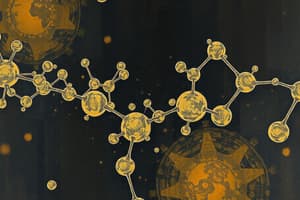Podcast
Questions and Answers
What type of bond is characterized by the sharing of electron pairs between atoms?
What type of bond is characterized by the sharing of electron pairs between atoms?
- Ionic bond
- Metallic bond
- Covalent bond (correct)
- Polar bond
Which statement is true about intermolecular forces?
Which statement is true about intermolecular forces?
- They can only be present in liquid states.
- They are stronger in ionic compounds than in molecular compounds.
- They are generally weaker than covalent bonds. (correct)
- They determine the identity of a compound.
In the context of VSEPR theory, the shape of a molecule is primarily determined by what factor?
In the context of VSEPR theory, the shape of a molecule is primarily determined by what factor?
- The size of the peripheral atoms
- The electronegativity of the central atom
- The type of chemical bonds present
- The number of lone pairs and bonding pairs of electrons (correct)
What is the correct order of increasing bond strength for the following types of bonds?
What is the correct order of increasing bond strength for the following types of bonds?
Which of the following compounds is a weak electrolyte?
Which of the following compounds is a weak electrolyte?
What does dimensional analysis help to determine when using density in calculations?
What does dimensional analysis help to determine when using density in calculations?
Which of the following describes the photoelectric effect?
Which of the following describes the photoelectric effect?
Which statement about atomic orbitals is true?
Which statement about atomic orbitals is true?
What does VSEPR theory primarily analyze?
What does VSEPR theory primarily analyze?
Which of the following represents a correct way to determine bond polarity?
Which of the following represents a correct way to determine bond polarity?
Flashcards
Molar Mass Calculation
Molar Mass Calculation
Determining the mass of one mole of a substance, using atomic masses from the periodic table
Mole Conversions
Mole Conversions
Converting between moles, number of particles (atoms/molecules), and mass of a substance using Avogadro's number.
Limiting Reactant
Limiting Reactant
Reactant that is completely used up in a reaction; dictates max product yield; determines the amount of product formed from reactants involved.
Empirical Formula
Empirical Formula
Signup and view all the flashcards
Solution Concentration Units
Solution Concentration Units
Signup and view all the flashcards
Metric Prefixes
Metric Prefixes
Signup and view all the flashcards
Significant Figures
Significant Figures
Signup and view all the flashcards
Dimensional Analysis
Dimensional Analysis
Signup and view all the flashcards
Subatomic Particles
Subatomic Particles
Signup and view all the flashcards
Periodic Table Groups
Periodic Table Groups
Signup and view all the flashcards
Study Notes
Exam 2
- Chapter 4 - pages 187–195, questions 4.1–4.8
- Identify types of chemical bonds (4.1)
- Compare atomic electronegativities and use them to determine the polarity of bonds (4.2)
- Name compounds and write formulas including polyatomics, acids, and bases (4.3)
- Draw Lewis symbols and structures (4.4)
- Determine resonance, apply formal charges, determine exceptions, and identify bond order where necessary for Lewis structures (4.5, 4.7, 4.8)
- Evaluate bond order, bond energies, and bond lengths (4.6)
Exam 3
- Chapter 5 - pages 243–247, questions 5.1–5.4, 5.11–5.78
- Apply VSEPR theory to molecular shape, polarity and dipole moment (5.1 – 5.3)
- Interpret the valence bond theory and hybridization of atomic orbitals (5.4–5.5)
- Chapter 6 - pages 281–283, questions 6.1–6.4, 6.17–6.44
- Identify intermolecular forces and apply them to physical changes (6.1–6.3)
Exam 4
-
Chapter 7 - pages 324–333, questions 7.1 – 7.110
- Write and balance chemical reactions (7.1, 7.2)
- Apply stoichiometry to reactions using solids and solutions (7.3)
- Find the limiting and excess reagent, theoretical yield and percent yield (7.4)
- Calculate percent composition and empirical formulas (7.5)
- Compare empirical and molecular formulas (7.6)
- Determine a formula of a compound through combustion analysis (7.7)
-
Chapter 8 - pages 384–391, questions 8.1 – 8.110
- Convert between different units of solution concentrations and apply dilutions (8.1, 8.2)
- Identify electrolytes, nonelectrolytes and weak electrolytes (8.3)
- Write molecular, ionic and complete ionic reactions for:
- weak and strong acids and bases (8.4)
- the application of solubility rules for precipitation reactions (8.6)
- Identify Brønsted-Lowery acids and bases (8.4)
- Recognize unsaturated, saturated, and supersaturated solutions (8.6)
- Apply stoichiometry and solution concentrations to titrations (8.5)
- Assign oxidation numbers to atoms in compounds (8.7)
- Identify and balance redox reactions in acid solutions (8.7)
-
Chapter 21 - pages 1018–1027, questions 21.1–21.5, 21.11 and 21.12
- Determine the type of radioactivity based on nuclear reactions (21.1)
-
Chapter 2 - pages 79–81, questions 2.43 – 2.82
- Calculate the molar mass of atoms, ions and molecules (2.4, 2.5)
-
Chapter 3 - pages 134–142, questions 3.1 – 3.38, 3.45 – 3.116, 3.119 – 3.122
- Recognize and name elements and groups on the periodic table (2.3)
- Describe and convert between wavelength, frequency, and the energy of light (3.1 – 3.3)
- Describe the photoelectric effect and how it demonstrates the particle nature of light (3.1 – 3.3)
- Describe and apply the Bohr model, De Broglie wavelengths and quantum numbers (3.4–3.6)
- Identify the shapes of atomic orbitals (3.7)
- Determine electron configurations of ions and atoms and magnetic properties (3.8, 3.9)
- Interpret periodic trends of radii size of atoms and ions (3.10)
- Interpret periodic trends of ionization energy and electron affinities (3.11–3.12)
Studying That Suits You
Use AI to generate personalized quizzes and flashcards to suit your learning preferences.




